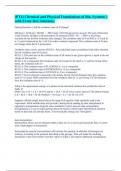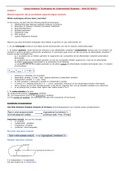with Error-free Solutions.
During Reaction 2, did the oxidation state of N change?
NH3(aq) + CO2(aq) + H2O(l) → NH4+(aq) + HCO3-(aq) correct answers The part of Reaction
2 that involves nitrogen is the protonation of ammonia (NH3 + H+ →NH4+). Acid-base
reactions do not involve oxidation state changes. The oxidation state of N in NH3 is -3. Each H
is +1 and is balanced by the -3 of N to make a neutral compound. The oxidation state of N does
not change when the N is protonated.
Oxidation rules correct answers RULE 1: Any individual atom uncombined with other elements
has the oxidation state of 0 (zero).
RULE 2: The total sum of the oxidation state of all atoms in any given species is equal to the net
charge on that species.
RULE 3: In a compound, the Oxidation state for Group 1(1A) metal is +1 and for Group 2(2A)
metal, the oxidation state is +
RULE 4: The oxidation state of FLUORINE is -1 in a compound.
RULE 5: The oxidation state of HYDROGEN is +1 in a compound.
RULE 6: The oxidation state of OXYGEN is -2 in a compound.
RULE 7: In two-element compounds with metals, Group 15(3A) elements have the oxidation
state of -3, Group 16(6A) elements have the oxidation state of -2, and Group 17(7A) elements
have the oxidation state of -1.
What is the approximate energy of a photon in the absorbed radiation that yielded the data in
Table 1?
(Note: Use 1 eV = 1.6 × 10-19 J and hc = 19.8 × 10-26 J•m.) correct answers The photon energy
is E = hc/λ = 19.8 × 10-26 J•m/(625 × 10-9 m) = 3.1 × 10-19 J ≅ 2 eV.
Suppose a blood sample tested above the range (6.0 mg/dL) of the standards used in the
experiment. What modification will provide a more precise reading by data interpolation as
opposed to extrapolation using the same standards? correct answers data extrapolation:
Extrapolation is a way to make guesses about the future or about some hypothetical situation
based on data that you already know. You're basically taking your "best guess".
data interpolation:
Interpolation allows you to estimate within a data set; it's a tool to go beyond the data. It comes
with a high degree of uncertainty.
Increasing the enzyme concentration will increase the quantity of absorber (chromogen) in
solution, according to the protocol described in the passage. This will make the resulting
absorbance value even further from the values in Table 1 and require additional extrapolation.
, Increasing the oxygen pressure will increase the quantity of absorber (chromogen) in solution,
according to the protocol described in the passage. This will make the resulting absorbance value
even further from the values in Table 1 and require additional extrapolation.
The oxygen acceptor is glucose. Removing glucose from the solution is not feasible and defies
the logic of the experiment, which involves quantifying the amount of glucose present. One
would need to know exactly how much glucose was removed, and this would require a separate
measurement.
By adding solvent, the concentration of glucose will be lowered, and the resulting absorbance
will fall within the range of the standards. This is easily accomplished, and the resulting
calculations that account for the dilution are not difficult.
Which of the following oxidative transformations is unlikely to occur?
A primary alcohol to an aldehyde
B.
A tertiary alcohol to a ketone
C.
An aldehyde to a carboxylic acid
D.
A secondary alcohol to a ketone correct answers The conversion of a primary alcohol to an
aldehyde is readily accomplished.
Oxidation of tertiary alcohols is difficult because it involves C-C bond breaking.
The conversion of an aldehyde to a carboxylic acid is readily accomplished.
The conversion of secondary alcohols to ketones is readily accomplished.
According to the IUPAC, what is the systematic name for the hydrocarbon shown?
A.
Z-3-methylpent-2-ene
B.
E-3-methylpent-2-ene
C.
Z-3-ethylbut-2-ene
D.
E-3-ethylbut-2-ene correct answers By IUPAC rules, first identify the longest unbroken chain of
carbon atoms. Next, number the carbon atoms in this chain starting from the end that gives C=C
the lowest numbers. The double bond is identified by the position of the carbon atom from the
lowest numbered end (2), and then the methyl group is assigned at the 3-position. The
stereochemical designator for the double bond is Z because the highest priority groups (methyl at
C2 and ethyl at C3) occur on the same side of the double bond. The name is therefore Z-3-
methylpent-2-ene.



